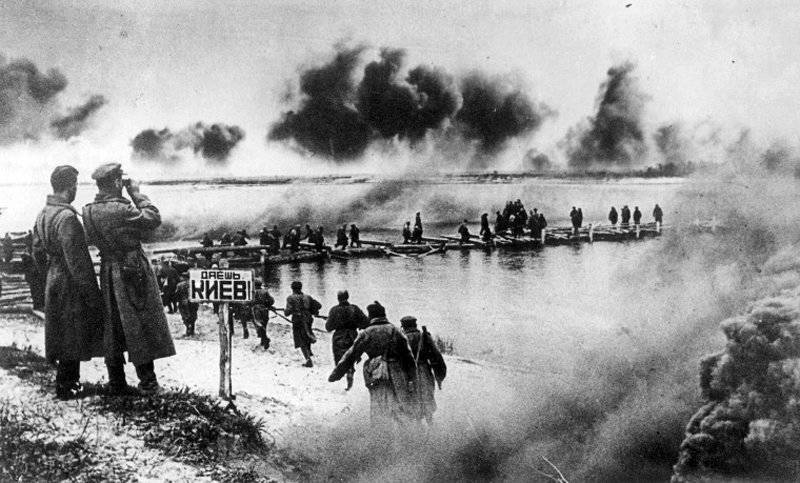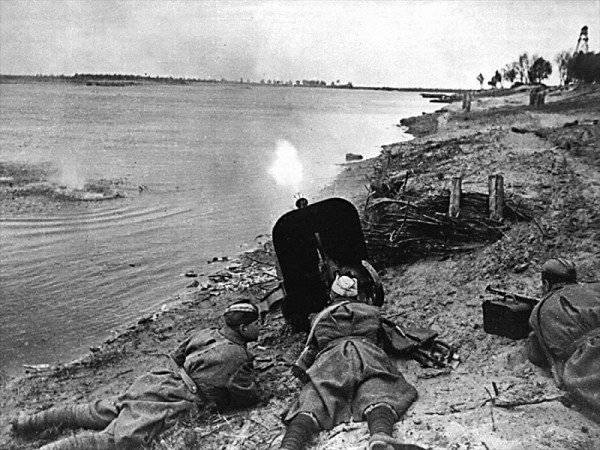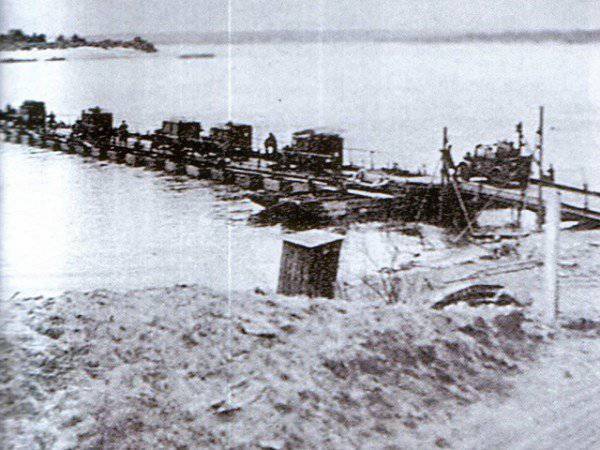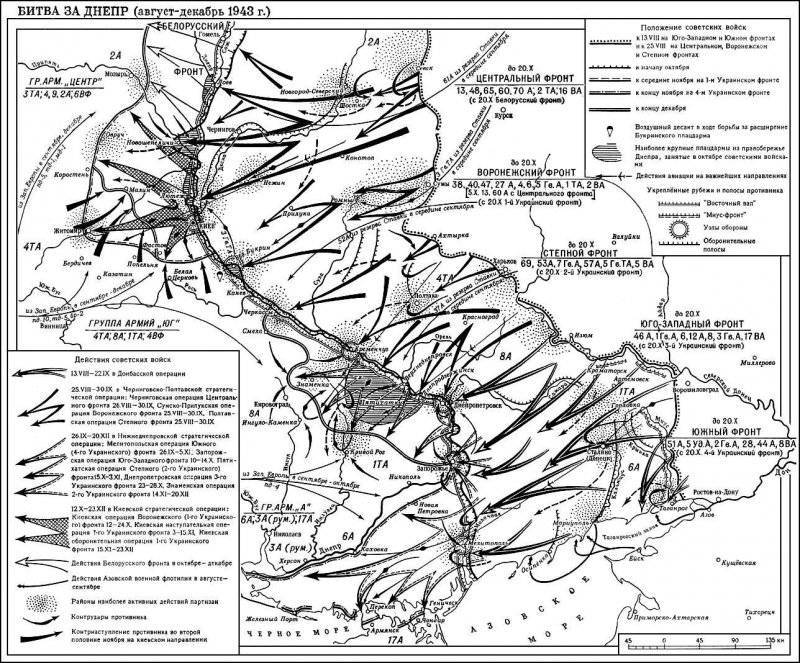To the 70 anniversary of the Battle of the Dnieper. Soviet offensive on the left bank

70 years ago began the hard battle for the Dnieper. This battle was one of the three biggest battles of 1943. If in the Battle of Stalingrad, Hitler's troops inflicted a heavy defeat, they lost hope at Kursk to reverse the outcome of the war in their favor, the battle on the Dnieper showed that the Wehrmacht were no longer able to stop the advance of the Red Army, even using a convenient natural frontier.
The battle began at the end of August and lasted until the end of December 1943. On both sides in the battle for the Dnieper took part up to 4 million people, and its front stretched to 750 kilometers. As a result, Soviet troops were able to liberate Left-Bank Ukraine, force the Dnieper and create several large bridgeheads on the right bank, as well as liberate one of the main cities of the USSR - Kiev. Millions of people, the most important industrial centers of Donbass and southern Ukraine, were freed from the invaders.
Before the battle
After a heavy defeat at Kursk, the loss of Orel, Belgorod and Kharkov, the German high command was forced to adopt a defensive strategy of warfare. The Wehrmacht suffered heavy losses in manpower, materiel, replenishment had worse fighting qualities than retired fighters (both in morale and technical skills, physical parameters). The Soviet army, on the contrary, strengthened, its morale increased - it was already an army of winners, liberators of its native land, the generals and commanders gained invaluable experience, the Soviet industry continued to increase the production of military equipment, weapons, their quality has grown. As a result, the German troops could now only rely on tactical success, and not on the interception of a strategic war initiative.
Back in the midst of the battle of Kharkov, Hitler announced the creation of the so-called. "East Wall". On August 12, the command of the 4 army groups on the Eastern Front received an order from the Führer to immediately build the Eastern Wall. It was supposed to become a frontier on which it was necessary to gain a foothold, to resist and, having exhausted the Red Army in defensive positional battles, to be able to conduct offensive operations. "East shaft" was held in the defense zone of the army groups "North", "Center", "South" and "A". It had to form an impermeable barrier for the "Bolsheviks" from the Sea of Azov to the Baltic. The line of defense passed along the Kerch Peninsula, the Molochnaya River, the Dnieper River Flood, the middle course of the Dnieper, the Sozh River to Gomel, further east of Orsha, Vitebsk, Nevel, Pskov, and the Narovo River. In the north, the defensive line was called “Panther”. It consisted of two frontiers: the first passed along the coast of the Pskov Lake, the Velikaya, Pskov, Cherekh rivers, the second went along the western bank of the Velikaya River and the Narovo to the Baltic Sea near Narva. The southern part of the “Eastern Wall” was called the “Wotan Line”, its basis was the middle course of the Dnieper. The Dnieper is the third largest river in Europe after the Volga and Danube (except for the Ural River) and was a serious natural obstacle.
Hitler gave the order at all costs to keep the defense on the "East shaft". Ukraine was an important resource base, its loss seriously undermined the economic opportunities of Germany. In the Third Reich and the troops Goebbels propaganda tried to present the Dnieper impregnable barrier. In addition, the German command thought that after the heavy and bloody previous battles, the Red Army would no longer be able to launch a major offensive in the 1943 year. The Germans underestimated the capabilities of the Soviet troops.
Army engineer units, a Todt organization, were involved in the construction of the “shaft”, the Soviet population was mobilized by force. In the most dangerous places they tried to build a multi-line defense. In a number of areas on the left bank of the Dnieper, the Germans built bridgeheads. It should be noted that, despite the loud name and the scale of the plans, the hopes that the "East Wall" would hold the Red Army were small. The Soviet army was already advancing, and the Germans did not have time to create a reliable defense line with powerful engineering structures in such a short period of time. They tried to build the strongest defenses in the places of the most probable crossing of the enemy troops. In particular, in Kremenchug, Nikopol, in Zaporizhia. In addition to defensive measures, the Wehrmacht and the SS units on the territory to be left, carried out the scorched-earth tactics. It was accompanied by a massive hijacking and the destruction of the civilian population, the erasure of dozens and hundreds of villages from the face of the earth, the destruction of transport, industrial infrastructure, life support systems, etc.
4 September 1943, the year Hitler ordered the withdrawal of troops from the Kuban bridgehead. 17 th army began to withdraw from the Kuban bridgehead through the Kerch Strait to the Crimea. The forward Kuban bridgehead, which was supplied through the strait, did not fit well into the plan to build a solid defense on the Eastern Front. In addition, the troops of the 17 Army were needed to solve other problems.
Considering the industrial and agricultural significance of Ukraine for the Union, the high population density of the Ukrainian regions, the presence of important coal and other deposits, the south made the main direction of the attack of the Red Army. The first to break through the enemy defenses were the troops of the Central, Voronezh, Steppe, South-Western and Southern fronts. The tasks of the last four fronts were defined by the Supreme Command Rate Directive No. 30165, which was sent to headquarters on the night of August 12 1943, even during the implementation of Operation Rumyantsev. The Voronezh Front, under the command of Nikolai Vatutin, after the defeat of the enemy forces in the Kharkiv region, was to advance in the direction of Poltava, Kremenchug, reach the Dnieper River, force it and capture bridgeheads on the right bank. The steppe front, under the command of Ivan Konev, after the liberation of Kharkov, was to continue the offensive in the general direction of Krasnograd, Verkhnedneprovsk, reach the Dnieper River in the area of Dnipropetrovsk and seize the crossings over the river.
The South-Western Front, under the command of Rodion Malinovsky, advanced from the Izyum area, the Mother of God in the general direction of Barvenkovo, Pavlograd, Orekhov, and had to go to the Zaporozhye area, Orekhov, if possible, cutting off the withdrawal paths of the Donbas enemy grouping. In fact, the South-Western and Southern fronts continued the Donbass operation (Battle for Donbass. Mius-Front Breakthrough). The southern front of Fyodor Tolbukhin was in cooperation with the troops of the South-Western Front to defeat the enemy grouping in the Donbass. The South-Western and Southern fronts were to go to the lower reaches of the Dnieper River and the Crimea. The southern front broke through the defense of the enemy on Mius at the end of August 1943. The 6-I German army retreated to the Molochnaya River, to the “Votan Line”.
At the same time, the troops of the Western Front, under the command of Army General Vasily Sokolovsky and the left wing of the Kalinin Front, Army General Andrei Eremenko were supposed to hit the enemy in the Smolensk direction. Thus, the German command was deprived of the opportunity to transfer troops from this section of the Eastern Front to the south. The offensive of the Southern Front was facilitated by the Azov flotilla. And partisan formations were involved in the operation to force the Dnieper.
The Soviet command wanted to capture several bridgeheads on the Dnieper on the move. On the one hand, it dispersed the forces of the Red Army. But, on the other hand, it gave the opportunity to mislead the enemy regarding the actual direction of the main strike (or two blows).

Correlation of forces
Against the forces of the Voronezh, Steppe, Southwestern and Southern Fronts, troops of the 2nd Army from the Army Group Center acted under the command of Field Marshal Günther von Kluge, 4th tank Army, 8th Army, 1st Tank Army and 6th Army of the German Army Group South, Field Marshal Erich von Manstein. The enemy's grouping totaled 62 divisions, including 14 tank and motorized. In total, the German armies included about 1 million 250 thousand people, 2,1 thousand tanks and self-propelled guns, 12,6 thousand guns and mortars, and 2,1 thousand combat aircraft.
The Central Front consisted of: 13-I, 48-I, 65-I, 60-I, 70-I armies, 16-I air army. In mid-September, 1943 was transferred to the front of the front 61-th army, 2-th tank army. The central front of October 20 was transformed into the Belarusian Front 1. The Voronezh Front was composed of troops of the 38, 40, 47 and 27 armies, 4, 6 and 5 guards armies, 1-th tank army and 2-th air army. In the first half of September, the 52 Army, the 3 Guards Tank Army and the 1 Guards Cavalry Corps were transferred from the Reserve to the HF from the reserve. In early October, the 13 and 60 armies were transferred from the Central Fleet to the HF. October 20 VF was renamed 1-th Ukrainian Front. The steppe front (the future 2-th Ukrainian Front) included 69-th, 57-th, 53-th army, 7-th guards army, 5-th air army. In mid-September, from the reserve, Stakes in the Federation Council transferred the 37 Army and the 5 Army Guards Tank Army. The South-Western Front (3-th Ukrainian Front) had 46, 6, 12-th army, 1-th, 8-th and 3-th Guards Army, 17-th air army, 23-th Tank Corps, 1 Guards Mechanized Corps. The Southern Front (4-th Ukrainian Front) included the 51 Army, 5-th Shock Army, 2-th Guards Army, 28-th, 44-th Army, 2-th and 4-th Guards Mechanized Corps, 4-th Guards Cavalry Corps and 8-th Air Army. The whole grouping of Soviet troops consisted of more than 2,6 million people, more than 2,4 thousand tanks and SPG, more than 2,8 thousand aircraft and more than 51,2 thousand guns and mortars.
Soviet offensive on the left bank
26 August 1943, the Soviet troops began to move on a huge front from the Sea of Azov to Smolensk - 1400 km. German troops resisted stubbornly, clinging to each locality. Widely used reinforced rearguard, which, relying on the nodes of resistance and skillful maneuvering fire weapons (armored vehicles, guns, mortars, machine guns), delayed the offensive of the Soviet troops. However, by the beginning of September, the forces of the Central Front (the Chernigov-Pripyat operation) broke through the enemy defenses in the offensive zone of the 60 Army I.D. Chernyakhovsky. 60-I army attacked the auxiliary, Konotop direction, where the enemy did not expect a strong blow. Rokossovsky immediately transferred the main forces of the front to this sector and transferred troops of the 2 tank and 13 armies, the 4 armored artillery corps, and other units. The main forces of the 16 Air Army were also concentrated here.
The Soviet troops were able to force the Sejm on the move, September 6 was occupied by Konotop, September BNmachx was liberated, September 9 was liberated by Nezhin. Over the 15 days, the troops of the Central Fleet advanced 20 km. The German command, trying to establish the offensive of the Soviet troops, threw 230 tank and 2 infantry divisions into battle, deployed considerable forces of the Luftwaffe. However, these units were brought into battle by parts, and they could not stop the advance of the Soviet troops. The troops of the right wing of the front, using the success of their neighbors, also launched an offensive and, forcing the Desna, on September 3 occupied Novgorod-Seversky. In fact, the German defense collapsed.
On September 21, the left wing of the Central Fleet liberated Chernigov and went to the Dnieper. On September 22, units of Lieutenant General N. P. Pukhov's 13 Army forced the Dnieper on the move. During the day, Soviet troops advanced between the Dnieper and Pripyat rivers, captured on the right bank of the Pripyat bridgeheads with a depth of 35 and a width of 30 — 35 km. 60-I army occupied a springboard in the area of the mouth of the river Grouse. Expanding it a day in depth to 15 and width in 20 km. The 61 Army I, Lieutenant General P.A. Belov, captured a foothold in the Loyev area. German troops could not stop the Red Army at the turn of the Dnieper, and were forced to conduct heavy fighting on the right bank, suffering significant losses in counterattacks. The 48 Army I Lieutenant General P.L. Romanenko and the 65 Army I Lieutenant General P.I.Batov occupied small bridgeheads on the right bank of the river Sozh, on the Gomel direction. By the end of September, the troops of the Federal Front were well consolidated on the right bank of the Dnieper and repulsed the first blows of the enemy. All attempts by the German troops to eliminate the bridgeheads of the Central Front failed.
28 September The headquarters redirected the TF from Kiev to Gomel direction. Kiev was to liberate the Voronezh Front. The VF front did not advance as successfully as the TF, therefore Rokossovsky had to transfer to him some of the forces. According to Rokossovsky, it was a mistake. With the collapse of the German defense in the area of the Central Front, Rokossovsky could liberate Kiev before the Voronezh Front.
Manstein asked the high command of the 12 for new divisions, hoping to stop the Soviet offensive. However, there was no fresh reserves. 15 September 1943, Hitler ordered to retreat to the Dnieper. The speed of withdrawal of troops to the Dnieper was determined only by their capabilities. Began running to the Dnieper. The commander of Army Group South, Manstein, determined the following final areas for the armies. 6-I Hollidt army was to retreat to the area south of Zaporozhye, between Melitopol and the Dnieper arc; 1-I tank army Mackensen in the area of Zaporozhye and Dnepropetrovsk; Wöler's 8 Army - in the Kremenchug and Cherkassy region; 4-I tank army Gota retreated to the line of the Desna and the Dnieper, left flank to Chernigov, right to Kanev. German troops destroyed everything they could not take with them. They drove away all vehicles, livestock, people were taken by rail, machines, various equipment, grain, etc.
"Running to the Dnieper" was accompanied by huge losses in manpower and equipment. According to Manstein, 5 divisions have completely lost their combat capability, their remnants were distributed among other divisions. Each remaining division was supposed to defend a plot of 20 km at the Dnieper turn. The divisions of the first echelon had thousands of combat-ready soldiers in 1, taking into account the promised reinforcements, in 2 thousands of people. Therefore, Manstein doubted that even at such a frontier as the Dnieper, a stable defense could be organized. Not a single tank and motorized division possessed complete combat capability.

Actions Voronezh Front. The Voronezh Front launched an offensive on August 25, when the Germans began to leave the Akhtyrka Ledge. In 2 of the day, the front left wing advanced to a depth of 25-30 km. In early September, Sumy was released. The front developed an offensive in the direction of Romny, Pereyaslav. In mid-September, the front was reinforced by the 3-th Guards Tank Army and the 1-th Guards Cavalry Corps. 3-I Guards Tank Army Rybalko was a serious force - around 700 tanks and SPG. The tank army was to force the Dnieper and advance in the direction of the White Church. But the advance to the Dnieper was hampered by the fact that the enemy on the way to the great river destroyed all the crossings, bridges on the rivers Psel, Sula, etc., mined the roads. The troops of the Voronezh Front tried to break through to the other side on the shoulders of the enemy, but did not. German troops successfully crossed over to the right bank, destroying all the crossings behind them. Another problem was the lack of transfer means. The forward detachments were forced to search for boats, build rafts from improvised means.
By September 9-10, the troops of the right wing of the VF reached the Khorol River, the troops of the center approached Psyol. Until September 15, on the line of Khorol, Psëla, Suda, and Romain, Soviet troops fought with the enemy, who tried to stop the Red Army at these advantageous defense lines. Since September 16, German resistance has dramatically weakened. The German command, having lost hope of holding back the Soviet offensive on the Kiev direction, began to hastily withdraw troops over the Dnieper. In addition, the sharp retreat of the enemy troops was caused by the success of the offensive of the Central Front troops in the Nizhyn direction, as well as in the South-Western and Southern fronts in the Donbas and Dnepropetrovsk directions. The troops of the right wing and center of the Voronezh Front launched an offensive and began to advance 30-35 km per day or more.
To be continued ...
- Alexander Samsonov
- To the 70 anniversary of the Battle of the Dnieper. Soviet offensive on the left bank
To the 70 anniversary of the Battle of the Dnieper. Soviet offensive on the left bank. Part of 2

Information